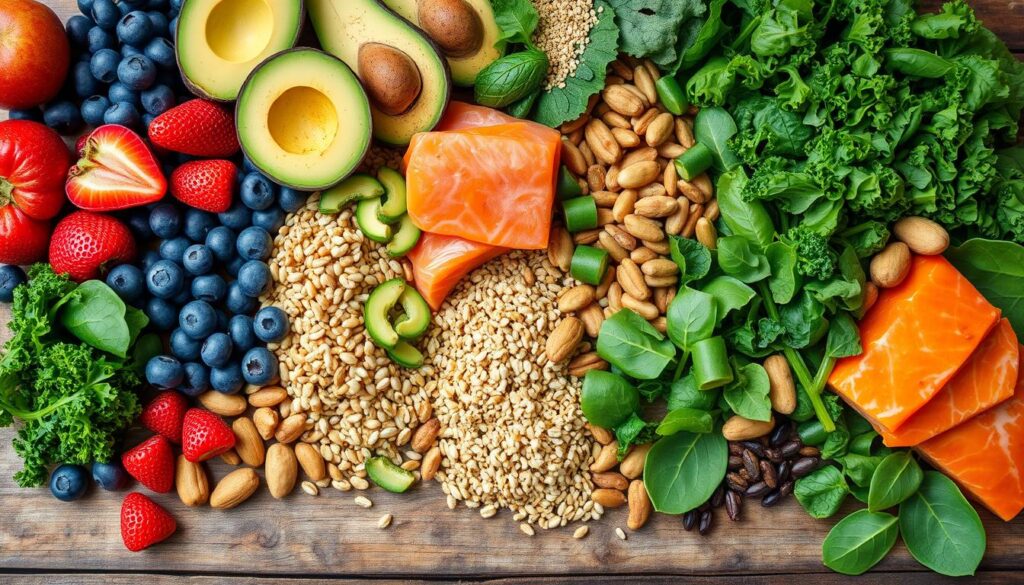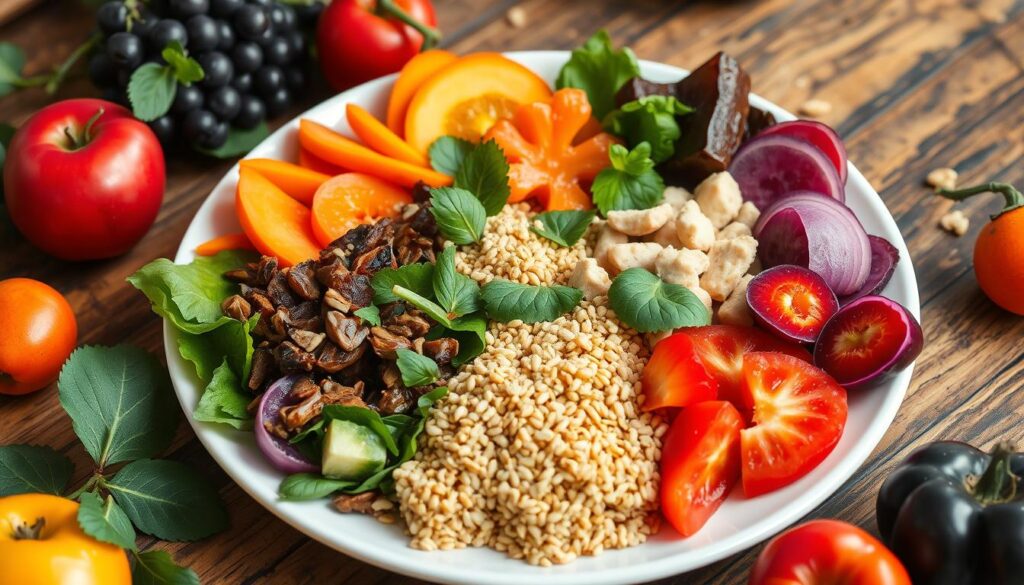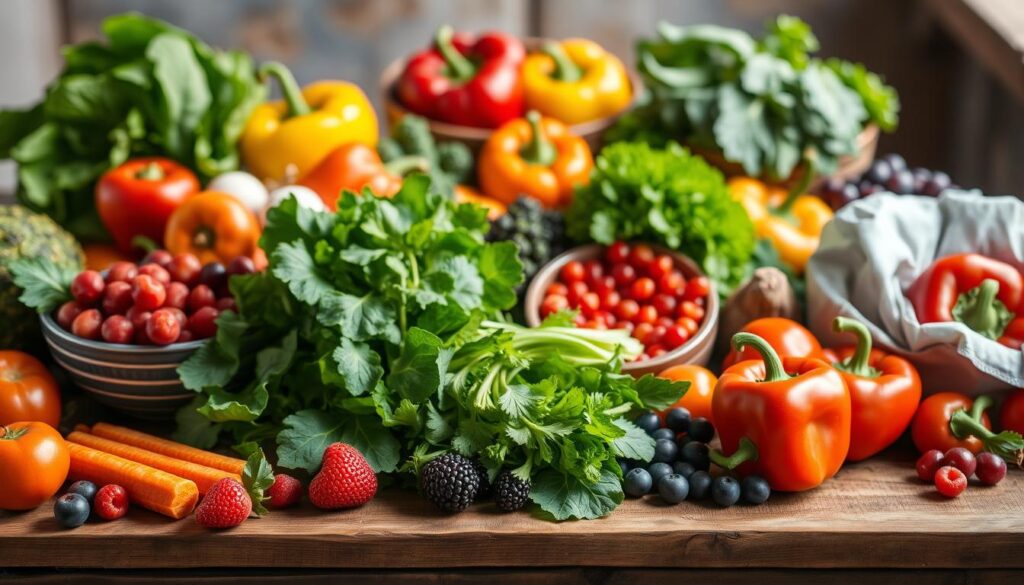Imagine waking up full of energy, ready to take on the day. Your body is fueled by a balanced diet that makes you feel great. We’ll show you how easy it is to get the nutrients you need from whole foods.
But, you might wonder: Are you getting the nutrients your body needs? Many of us find it hard to eat well, thanks to false claims or not knowing where to start. Don’t worry, we’re here to help you on your journey to better health.
Key Takeaways
- Discover the fundamental nutrients your body needs for optimal health and wellness.
- Learn how to build a balanced plate that fuels your body with the right combination of macronutrients.
- Explore the power of whole, minimally processed foods and how they can revolutionize your diet.
- Uncover practical meal planning strategies to make healthy eating sustainable and stress-free.
- Dispel common nutrition myths and misconceptions to empower you on your path to better health.
Understanding the Fundamentals of Healthy Eating
Exploring nutrition can seem daunting, but don’t worry! We’re here to simplify the basics that keep our bodies healthy. We’ll cover essential nutrients, macronutrients, and vitamins and minerals. Get ready to become a nutrition pro.
Key Nutrients Your Body Needs Daily
Good nutrition begins with knowing the core nutrients your body needs. Let’s explore:
- Protein: Builds cells, aids in growth, repair, and muscle upkeep.
- Carbohydrates: Our main energy source, powering brain and body activities.
- Healthy Fats: Essential for hormone production, brain health, and nutrient absorption.
- Fiber: Boosts digestive health and keeps blood sugar stable.
- Water: Keeps us hydrated and supports bodily functions.
The Role of Macronutrients in Your Diet
Macronutrients are the big players in nutrition. Knowing how protein, carbs, and fats work together is crucial for a balanced diet.
| Macronutrient | Function | Food Sources |
|---|---|---|
| Protein | Tissue repair, muscle growth, immune function | Lean meats, poultry, fish, eggs, legumes, nuts, seeds |
| Carbohydrates | Energy production, brain function, fiber | Whole grains, fruits, vegetables, legumes |
| Fats | Hormone production, nutrient absorption, brain health | Avocados, nuts, seeds, olive oil, fatty fish |
Essential Vitamins and Minerals
Along with macronutrients, vitamins and minerals are vital for our health. Key ones include:
- Vitamin C: Boosts immunity and aids in collagen production.
- Calcium: Builds and maintains strong bones and teeth.
- Iron: Ensures efficient oxygen transport and red blood cell function.
- Magnesium: Supports muscle and nerve function, energy production.
- Zinc: Helps with wound healing, immune function, and protein synthesis.
By grasping these basic elements of healthy eating, you’re set to make informed choices. These choices will nourish your body from the inside out.

“Eating a variety of nutrient-dense foods is the key to a healthy, balanced diet.”
Building a Balanced Plate for Optimal Nutrition
Healthy eating starts with a balanced plate. This simple method ensures your meals have the right nutrients. It helps you maintain a balanced diet, control portion sizes, and practice mindful eating.
Let’s explore the key parts of a balanced meal:
- Lean Proteins: Choose lean meats, poultry, fish, or plant-based options like beans and tofu for building blocks.
- Complex Carbohydrates: Whole grains like quinoa and brown rice give sustained energy and fiber.
- Vibrant Vegetables: Fill half your plate with colorful veggies for vitamins, minerals, and antioxidants.
- Healthy Fats: Add small amounts of heart-healthy fats like avocado and nuts for energy and nutrient absorption.
- Complementary Sides: Add fresh fruit or small portions of starchy veggies like sweet potatoes.
By balancing these food groups, you’ll make meals that are both good-looking and nourishing. Remember, portion control and mindful eating are key. Listen to your hunger and enjoy each bite.
| Food Group | Recommended Portion |
|---|---|
| Lean Proteins | 3-4 oz (approximately the size of a deck of cards) |
| Complex Carbohydrates | 1/2 cup (cooked) |
| Vegetables | 1 cup (raw) or 1/2 cup (cooked) |
| Healthy Fats | 1-2 tbsp (such as olive oil or avocado) |
| Complementary Sides | 1/2 cup (cooked) |
These are general guidelines. Your needs may change based on age, activity level, and health goals. Listen to your body and find the right balance for you.

“A balanced plate is not just about aesthetics, but about nourishing your body with the right combination of nutrients.”
Smart Food Choices: From Market to Table
Going to the grocery store can be tough, especially when you want to eat clean and whole foods. But don’t worry, we’ve got some easy tips to help you become a pro at picking healthy foods!
Reading Food Labels Effectively
Understanding food labels can seem hard, but it’s key for making smart choices. Look for short, easy-to-read ingredient lists. Stay away from foods with long lists of hard-to-pronounce additives or preservatives.
Choosing Fresh vs. Processed Foods
Try to pick fresh, whole foods over processed ones. Foods like fruits, veggies, whole grains, and lean proteins are full of good stuff. They have vitamins, minerals, and fiber that are great for your health. Processed foods often have less of these and may have added sugars, salts, and unhealthy fats.
Using Food Scan Genius for Better Shopping
Meet the Food Scan Genius app – your new nutrition buddy! Just scan a product’s barcode, and it will tell you about allergens, ingredients, and nutrition facts. It makes shopping easier and faster, so you don’t have to guess about food labels anymore!
“Eating healthy doesn’t have to be complicated. With the right tools and a little know-how, you can transform your grocery trips into a breeze.”
The Power of Whole Foods in Your Diet
Whole foods are the heart of a healthy diet. They are full of vitamins, minerals, and fibers that our bodies need. Eating whole foods gives our cells the right building blocks to stay healthy.
Whole foods include colorful fruits and veggies, whole grains, and lean proteins. They are nutrient-dense and help keep us healthy. By choosing clean eating and adding more whole foods to our meals, we see big changes.
- Whole foods are minimally processed, keeping their nutrients intact.
- They are full of fiber, which is good for our digestion and keeps us full.
- Whole foods have lots of antioxidants that fight off harmful free radicals.
- These foods give us steady energy, helping our bodies work well.
| Whole Food | Key Nutrients | Health Benefits |
|---|---|---|
| Blueberries | Vitamin C, Fiber, Antioxidants | Brain health, Immune support, Anti-aging |
| Quinoa | Protein, Fiber, Minerals | Balanced blood sugar, Heart health, Weight management |
| Salmon | Omega-3s, Protein, Vitamins | Brain function, Inflammation reduction, Cardiovascular health |
Adding more whole foods to our diets is a smart move for our health. By choosing nutrient-dense foods, we support our well-being. This way, we can enjoy the benefits of clean eating and feel our best.
The food you eat can be either the safest and most powerful form of medicine or the slowest form of poison.” – Ann Wigmore
Meal Planning Strategies for Success
Healthy eating doesn’t have to be hard. With a few smart tips, we can make nutritious food a part of our daily lives. These strategies work for busy parents and college students alike, helping you reach your healthy eating goals.
Prep Methods That Preserve Nutrients
Meal prep is all about how we cook our food. Steaming, baking, and sautéing are great because they keep vitamins and minerals in our food. But, avoid overcooking to keep these nutrients.
Time-Saving Meal Planning Tips
- Batch cook larger portions for meals all week.
- Use a meal planning app or calendar for your weekly menu and grocery list.
- Prep ingredients like chopped veggies, cooked grains, and marinated proteins ahead of time.
Budget-Friendly Healthy Eating
Nutritious eating doesn’t have to cost a lot. Choose affordable whole foods like beans, lentils, frozen produce, and seasonal fruits and veggies. Plan meals around these items to eat healthy without spending too much.
Meal planning is the key to making healthy eating a sustainable habit.
Understanding Portion Control and Mindful Eating
Healthy eating is all about portion control and mindful eating. Knowing the right portion sizes helps keep your diet balanced. It also stops you from eating too much. Mindful eating makes you enjoy each bite and stay in the moment. Let’s explore these important practices for better nutrition.
The Importance of Portion Control
Portion control means knowing how much food you eat. Eating too much, even healthy foods, can cause weight gain and health problems. Learning the right serving sizes helps you get the nutrients you need without overeating. Use nutrition labels and measuring tools to keep your portions right.
The Art of Mindful Eating
Mindful eating is about being fully present and attentive while eating. It’s about slowing down, enjoying the flavors, and listening to your body’s hunger and fullness signals. This practice helps you make better food choices and makes eating more enjoyable. Try to avoid distractions, eat slowly, and appreciate the taste and smell of your food.
Mastering portion control and mindful eating changes how you view food. It supports your health and wellbeing. It’s about finding balance and enjoying the journey of feeding your body.
The key to healthy eating is not deprivation, but rather learning to eat mindfully and finding the right balance.
Practical Tips for Portion Control and Mindful Eating
- Use smaller plates and bowls to help with portion control
- Slow down and savor each bite, putting your fork down between bites
- Drink a glass of water before and during your meal to stay hydrated
- Avoid eating in front of the TV or while using other devices to stay present
- Listen to your body’s hunger and fullness cues and stop eating when you feel satisfied
| Portion Control | Mindful Eating |
|---|---|
| Helps maintain a balanced diet and avoid overconsumption | Encourages you to be present and savor each bite |
| Involves using proper serving sizes and measuring tools | Helps you make healthier choices and enjoy the dining experience |
| Promotes weight management and overall health | Fosters a positive relationship with food |
Superfoods and Their Role in a Healthy Diet
Superfoods are the stars of nutrition, full of vitamins, minerals, and antioxidants. They boost your health and well-being. Adding them to your meals increases your nutrient intake and adds plant-based goodness to your diet.
Top Nutrient-Dense Foods to Include
There are many superfoods to choose from. Here are some of the best ones:
- Leafy greens like kale, spinach, and Swiss chard
- Berries, such as blueberries, raspberries, and acai
- Nuts and seeds, including almonds, walnuts, and chia seeds
- Cruciferous vegetables like broccoli, cauliflower, and Brussels sprouts
- Fatty fish, such as salmon, mackerel, and sardines
- Quinoa, a nutrient-dense whole grain
Incorporating Superfoods Into Daily Meals
It’s easy to add superfoods to your meals. Here are some ways to do it:
- Start your day with a superfood-packed smoothie, blending together greens, berries, and chia seeds.
- Sprinkle nuts and seeds onto your salads, oatmeal, or yogurt for an extra boost of nutrients.
- Roast or sauté cruciferous vegetables as a side dish or add them to stir-fries and soups.
- Swap out regular pasta for quinoa or opt for a salmon fillet instead of a beef burger.
- Snack on a handful of berries or enjoy a piece of dark chocolate, which is also considered a superfood.
Remember, a healthy diet is all about balance and moderation. Superfoods are great, but they should be part of a balanced diet. By adding these foods to your daily routine, you’ll boost your health and well-being.
Common Nutrition Myths Debunked
There’s a lot of wrong information about nutrition out there. Let’s clear up some common myths about eating healthy. Not all carbs are bad – whole grains are good for energy and gut health. Healthy fats in avocados, nuts, and olive oil are good for your heart and brain.
Many think you need a strict diet to be healthy. But, a balanced diet can be many things. It can be plant-based, Mediterranean, or flexitarian. The main thing is to eat whole, unprocessed foods. Snacking isn’t bad if you choose the right foods like fruits, veggies, and lean proteins.
Some think certain “superfoods” are the key to health. While foods like berries, leafy greens, and salmon are great, no one food is enough. The best thing is to eat a variety of foods. We’re here to help you do that.
FAQ
What are the key nutrients my body needs daily?
Your body needs a mix of macronutrients like proteins, carbs, and fats. It also needs essential vitamins and minerals. We’ll talk about these nutrients and how to get the right amounts in your diet.
How do I build a balanced plate for optimal nutrition?
Building a balanced plate is simple. We’ll give you tips on how to mix proteins, carbs, and veggies. This ensures you get all the nutrients your body needs in every meal.
How can I effectively read food labels and choose fresh over processed foods?
Reading food labels can help you make healthier choices. We’ll show you how to spot key nutrients and avoid additives. Plus, we’ll encourage you to choose fresh foods over processed ones.
What are the benefits of incorporating whole foods into my diet?
Whole foods are full of vitamins, minerals, and fiber. They support your health and well-being. We’ll explore their benefits and share ways to include them in your meals.
What are some effective meal planning strategies for successful healthy eating?
Meal planning is key to a balanced diet. We’ll share tips to save time and money. Plus, we’ll show you how to keep your meals nutritious and delicious.
How can I practice portion control and mindful eating?
Controlling portions and eating mindfully are important. We’ll give you strategies to listen to your hunger and enjoy your food. This way, you’ll find the perfect balance of satisfaction and nourishment.
What are superfoods, and how can I incorporate them into my diet?
Superfoods are packed with nutrients and can boost your health. We’ll introduce you to the best superfoods. Then, we’ll show you easy ways to add them to your meals and snacks.
What are some common nutrition myths that I should be aware of?
There’s a lot of false information about nutrition. We’ll clear up common myths. This way, you can make informed choices about what you eat.





